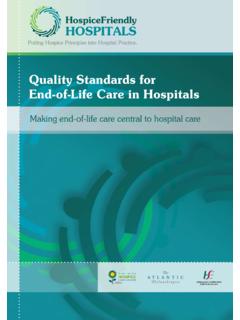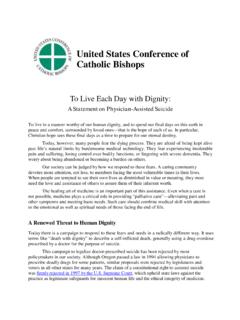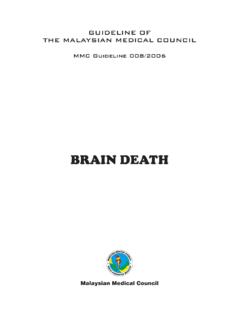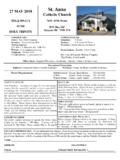Transcription of End-of-Life Care Resources Care After Death
1 Staff Resources Dying & Death in an Acute HospitalCare After DeathEnd-of- life care Resources End-of-Life care Resource Folder Version 1 care After Death1 When a Patient Dies - What happens next? Caring for a deceased person is one part of the overall continuum of care given to patients at the end of life and those close to them. At all times dignity and respect of the deceased person should be maintained. Below is a sample checklist for the care of the deceased patient, also refer to your hospital s Checklist1. Inform doctor to pronounce patient s Death and document date and time of Death in the patient s notes. 2. Notify next of kin and provide support to patient s Inform spiritual designate/chaplain, if . Doctor completes Death notification form within 3 working Place End-of-Life symbol at nurses station to notify staff a patient has died.
2 6. Offer support and reassurance to other patients who may be aware of the Contact bed manager and nursing administration to notify GP and out-of-hours doc on To allow for the preparation of the patient s body, bring family to a private room, provide refreshments, use of phone Prepare and lay out deceased patient using an end of life drape, observing rituals as appropriate and in line with the deceased patient s wishes all tubes and drains should be removed unless otherwise indicated, for example, in a coroner s Prepare family once again for viewing and advise the family of any deterioration in the patient s physical condition or of equipment that must be left in Allow time for spiritual care as appropriate. 12. At an appropriate time, return patient s valuables as per hospital Provide family with bereavement info pack drawing attention to mortuary viewing times and collection of Death notification.
3 Notify the mortuary porter to transfer deceased patient to Once porter arrives, accompany family into a private room/space and provide tea/coffee while porter prepares patient for Porter transfers patient to mortuary using End-of-Life 7. Document date and time patient was transferred to the mortuary in patient s Notify patient s GP and any other relevant services in the Send sympathy card to the family preferably within one week of patient s Finance department delays hospital bill for at least 6 weeks After patient s Death to avoid it arriving on the patient s month s Out-patient department notified to cancel any planned information below is from the Hospice Friendly Hospital Programme s Map for End-of-Life CareEnd-of- life care Resource Folder Version 1 2 care After Death06/07/2010 1 SAMPLE PROCESS MAP/PATHWAY - What to do when a patient dies care After DeathSample Process Map/Pathway - What to do when a Patient diesStandard procedures to be followed when a patient diesPatient s Name.
4 Chart No: :Nurses need to familiarise themselves with the following:a) Local policies on care of the Deceased Patient /Last Officesb) Information on Post Mortem Examinationsc) Local guidelines on care of patient s property and valuablesFollowing the Death of a patient please complete the following checklist:1 Inform the doctor to pronounce patient s An assessment should be made as to whether the Death needs to be reported to the coroner by ensuring that the patient s chart is the patient s next of kin3 Contact the Priest/Minister for spiritual care as appropriate4 Offer support to the family room, refreshments and the use of a telephone if required5 Inform the mortician of the Death on Ext:..Out of hours the patient s property to the family in the approved canvas valuables to the family as per hospital appropriate information leaflet(s).
5 To the family, following explanation9 Complete the Mortuary transfer form10 Death Notification form to be completed by the medical team (if not Coroner s case).11 Notify GP/ PHN12 Send sympathy card to the patient s familyIf there is no requirement for a post mortem and when the family have been afforded sufficient time with the deceased, the Last Offices should be performed as per s Name: Chart No: :Where the patient s Death falls into the category for referral to the Coroner, the following should be completed:1An information leaflet on Post Mortem Examination is given to relatives following Gardai have done a visual examination of the patient on the ward prior to transfer to the s Name: : Garda s Name: Garda Station.
6 Name of Relative Identifying the deceased:If the family does not speak English as their first language, please contact _____ so that suitable literature/ an interpreter can be Coroner s Post MortemInsert local guidelinesNurse s Name: Nurse s Signature: Please file this document with the patient s care Resource Folder Version 1 care After Death5 Last Offices Preparing YourselfWhat is Last Offices?Last offices - also known as the laying out of the dead refers to the care of a patient s body After they have died. It is an ancient ritual providing an opportunity for people to offer a final mark of respect to the deceased person. Historically, it was a procedure carried out by family members (and this may still be the preference in some religions Islam) but, in more recent times, it has become the responsibility of the nurse/ health care does it involve?
7 It occurs After the Death of the patient has been verified by the doctor and the family have been given the opportunity to view the body. Precise procedural aspects may vary in different organisations but usually include the following (observing universal precautions): Washing the body. Straightening the limbs Removal of mechanical equipment Removal of jewellery Covering of wounds with a waterproof dressing Dressing the body in clothes or a shroud Labelling the body Covering or wrapping the body in a sheetFor further information see reference1 How may I feel during last offices?During last offices you may experience a range of emotions especially if you have cared for the patient for a long time or you find the circumstances of their Death upsetting. Common experiences include the following - the quotes are from student nurses talking about their initial experiences of performing last offices.
8 See references 2, 31 Sewell, P. (2002). Respecting the patient s care needs After Death . Nursing Times. 98 (39) 36 37. Nearney, L. (1998). Last Offices 1, 2, 3. Nursing Times. 94 (26) Suppl 1-2; 94 (27) Suppl 1-2; 94 (28) Suppl Cooper, J. (2004). What aspects of caring for dying patients cause anxiety to first year student nurses. Unpublished dissertation. University of Cooper, J. & Barnett, M. (2005). Aspects of caring for dying patients which cause anxiety to first year student nurses. International Journal of Palliative Nursing. 11 (8) care Resource Folder Version 1 6 care After DeathCare After Death1. Positive aspects If I was really close to the patient I want to do last offices you know the last thing you can possibly do for them I want to be the one to do it. If you have cared for someone it is natural that you may feel upset or anxious when they die.
9 However, ensuring that the dead person is treated with the same level of respect and dignity as when they were alive can be a source of personal satisfaction. It may also provide you with the opportunity to say your own goodbyes to the You may feel scared about seeing a dead body for the first time. I felt a bit in the room with a dead body. This is perfectly natural and even if you have seen a dead person before you may feel differently now it is happening in a professional context. 3. Parts of the procedure may upset you. I felt quite upset removing her rings and jewellery. It can be quite distressing removing the personal effects from a patient that you have known and cared for because you may feel as though you are removing that person s identity. In particular the covering of the person with a sheet can be particularly distressing as it reinforces that they are really dead.
10 The part I disliked the most was covering .. up the head, at that point it felt like the time to really say goodbye. 4. Rituals Personally I found it difficult to talk to the patient. It made me feel uncomfortable when she didn t reply. Initially you may be shocked to observe that nurses often talk to the dead person during last offices. This is probably because it is very difficult for us to treat the patient differently now they are dead and we still want to be caring in our approach. However, most people find this helpful: I think it s easier to talk whilst you re doing it it feels less awkward. It made me feel like the person was still there at the end of the day. You may also observe other rituals such as the opening of the window to allow the soul to escape or the placing of a flower on the body. Such acts probably relate to the spiritual issues that Death raises and may provide an appropriate outlet for such offices is an important part of the care of patients, offering an opportunity for you to show dignity and respect to someone you have cared for.












